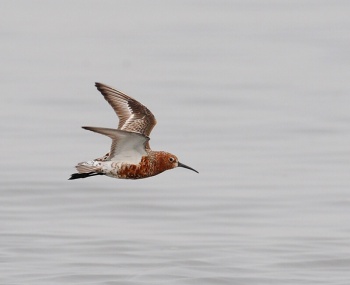- Calidris ferruginea
Identification
Length 18–23 cm, wingspan 38-41 cm, weight 44-117 g
- Long black de-curved bill
- White uppertail coverts and lower rump
- Longish black legs
Breeding adult
- Orange, black and white patterned above
- Brick red below
Non-breeding adult
- Pale sandy-grey upperparts
- White underparts
- White supercilium
Juvenile
- Grey and brown scalloped back
- White belly and flanks
- Peachy breast
Similar Species
Winter adult can resemble Dunlin; that differs in shorter bill, black stripe down the middle of the rump, and slightly shorter legs; juvenile Dunlin also differs in streaked flanks, and streaked (not peachy) breast. White-rumped Sandpiper and Stilt Sandpiper share white uppertail coverts in flight, but differ structurally; Stilt Sandpiper also has yellowish, not black, legs. Summer plumage Red Knot is larger and lighter, more orange-toned below, and has a shorter, straighter bill.
Distribution
Arctic Siberia, migrating through temperate Europe and Asia (north in May, and south in August-September) to winter in tropical Africa, south and southeast Asia and Australasia. A vagrant to North America.
Taxonomy
This is a monotypic species[1].
Habitat
Breeds on high arctic tundra; on passage and wintering in marshes, wet fields, muddy estuaries, and salt pans.
Behaviour
Diet
The diet includes snails, worms and flies.
Breeding
The nest is a ground scrape and 3-4 eggs are laid.
Vocalisation
Flight call: chirrip (lower pitched than Temminck's Stint)
References
- Clements, J. F., T. S. Schulenberg, M. J. Iliff, D. Roberson, T. A. Fredericks, B. L. Sullivan, and C. L. Wood. 2016. The eBird/Clements checklist of birds of the world: v2016, with updates to August 2016. Downloaded from http://www.birds.cornell.edu/clementschecklist/download/
- Wikipedia
- Collins Bird Guide ISBN 0 00 219728 6
Recommended Citation
- BirdForum Opus contributors. (2024) Curlew Sandpiper. In: BirdForum, the forum for wild birds and birding. Retrieved 20 April 2024 from https://www.birdforum.net/opus/Curlew_Sandpiper
Vocalisation
External Links
GSearch checked for 2020 platform.1







